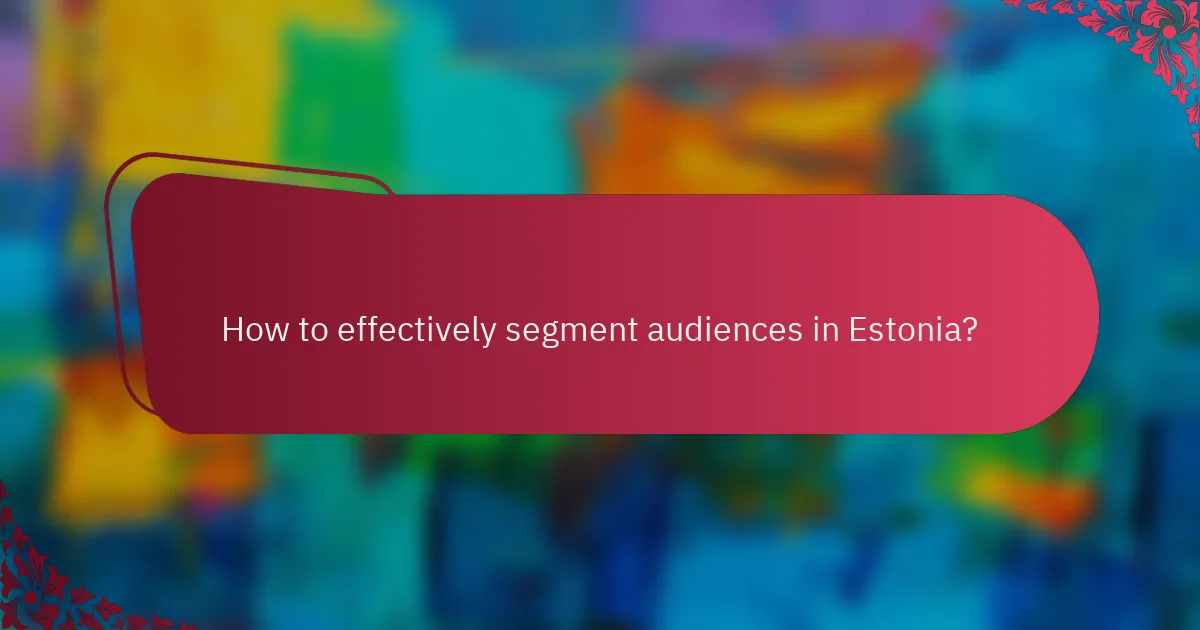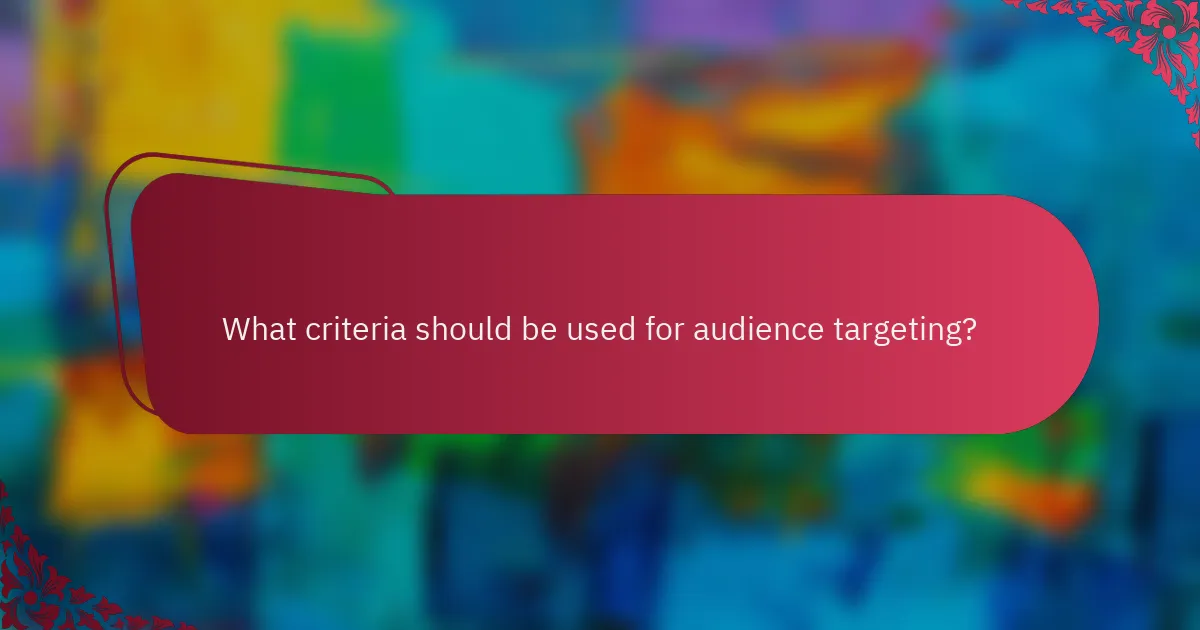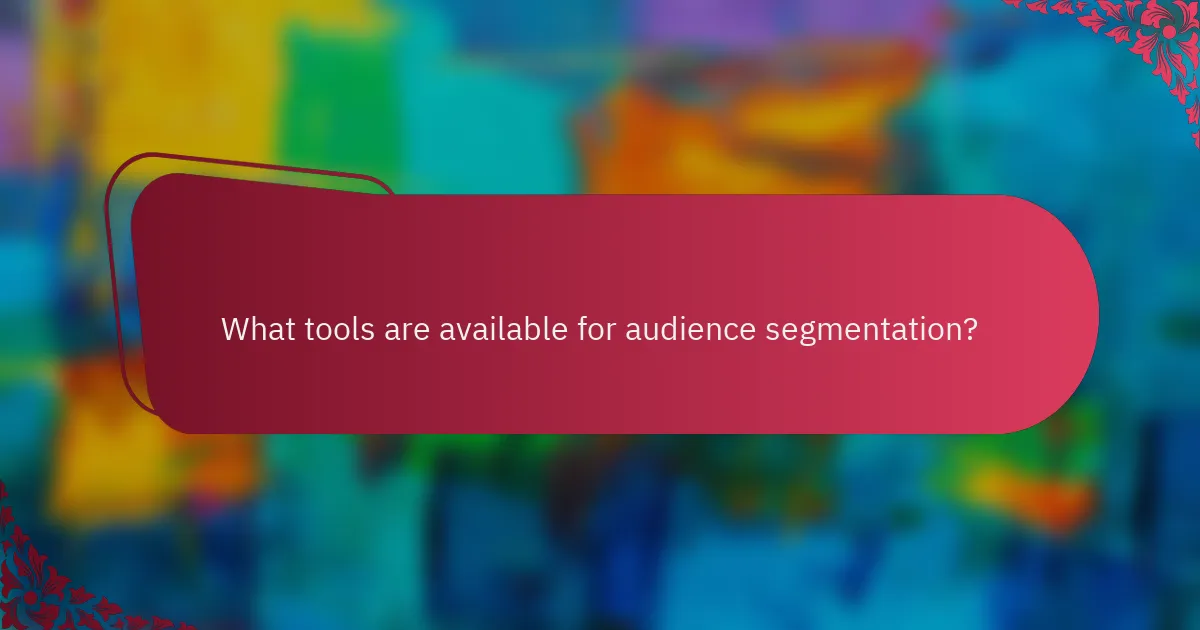Demographic targeting in Estonia is crucial for effective audience segmentation, allowing marketers to categorize potential customers based on specific characteristics. By understanding the preferences and values of Estonian audiences, particularly their inclination towards digital engagement, businesses can tailor their strategies to enhance interaction and improve conversion rates.

How to effectively segment audiences in Estonia?
Effective audience segmentation in Estonia involves categorizing potential customers based on various characteristics to tailor marketing strategies. This process enhances engagement by ensuring that messaging resonates with specific groups, leading to improved conversion rates.
Demographic segmentation
Demographic segmentation focuses on quantifiable characteristics such as age, gender, income, education, and family size. In Estonia, understanding these factors can help businesses target specific age groups, such as millennials or seniors, with tailored products or services.
For example, a company might market budget-friendly products to younger consumers while promoting premium offerings to higher-income brackets. This approach allows for more precise marketing strategies that align with the needs and preferences of different demographic groups.
Psychographic segmentation
Psychographic segmentation divides audiences based on their lifestyles, values, interests, and attitudes. In Estonia, this could involve identifying consumers who prioritize sustainability or those who value luxury experiences.
By understanding these psychological factors, businesses can create messaging that resonates on a deeper emotional level. For instance, a brand promoting eco-friendly products can appeal to environmentally conscious consumers by highlighting their sustainable practices.
Behavioral segmentation
Behavioral segmentation categorizes audiences based on their interactions with a brand, including purchasing behavior, usage frequency, and brand loyalty. In Estonia, analyzing customer behavior can reveal insights into seasonal buying patterns or product preferences.
For example, a retailer might notice that certain products sell better during specific holidays, allowing them to tailor promotions accordingly. Additionally, recognizing loyal customers can lead to targeted rewards programs that enhance retention.
Geographic segmentation
Geographic segmentation involves dividing audiences based on their location, such as urban versus rural areas or specific regions within Estonia. This method allows businesses to consider local preferences and cultural differences when marketing their products.
For instance, a food brand may offer different flavors or packaging sizes based on regional tastes, ensuring that their offerings are relevant to local consumers. Understanding geographic nuances can significantly improve marketing effectiveness.
Technographic segmentation
Technographic segmentation categorizes audiences based on their technology usage, including device preferences, software, and online behavior. In Estonia, where digital engagement is high, understanding these factors is crucial for effective marketing.
For example, a company might target younger audiences who primarily use smartphones for shopping, while older demographics may prefer desktop experiences. Tailoring marketing strategies to these technological preferences can enhance user experience and engagement.

What are the key preferences of Estonian audiences?
Estonian audiences prioritize digital engagement, valuing content that is relevant, accessible, and interactive. Understanding their preferences can enhance audience segmentation and improve engagement strategies.
Digital content consumption
Estonians show a strong preference for online content, particularly video and interactive formats. Streaming services and social media platforms are popular sources for entertainment and information, with many users consuming content on mobile devices.
Content that is concise and visually appealing tends to perform better. Brands should focus on creating high-quality visuals and short, engaging videos to capture attention effectively.
Social media engagement
Social media is a primary channel for Estonian audiences, with platforms like Facebook, Instagram, and TikTok being widely used. Users engage with brands that provide authentic interactions and respond promptly to inquiries.
To foster engagement, brands should create community-driven content, such as polls or user-generated posts, encouraging audience participation and feedback.
Brand loyalty factors
Estonian consumers are inclined towards brands that demonstrate transparency and social responsibility. They appreciate companies that align with their values and contribute positively to society.
Building brand loyalty requires consistent communication and delivering on promises. Brands should focus on customer service excellence and maintaining a strong online presence to reinforce trust and loyalty.

How to enhance engagement with Estonian audiences?
To enhance engagement with Estonian audiences, focus on personalized approaches that resonate with their preferences and cultural context. Utilizing targeted strategies can significantly improve interaction and connection with this demographic.
Personalized advertising strategies
Personalized advertising strategies are crucial for effectively reaching Estonian audiences. Tailoring ads based on user behavior, preferences, and demographics can increase relevance and engagement. For instance, using local language and cultural references in advertisements can create a stronger connection.
Consider segmenting your audience into distinct groups based on interests or purchasing behavior. This allows for more targeted messaging, which can lead to higher conversion rates. Utilizing data analytics tools can help identify these segments and optimize your advertising efforts.
Interactive content formats
Interactive content formats, such as polls, quizzes, and surveys, engage Estonian audiences by encouraging participation. These formats not only capture attention but also provide valuable insights into audience preferences and opinions. For example, a quiz about local culture can spark interest and promote sharing among users.
Incorporating gamification elements can further enhance engagement. Consider offering rewards or recognition for participation, which can motivate users to interact more frequently with your content. This approach fosters a sense of community and loyalty among your audience.
Community-building initiatives
Community-building initiatives are essential for fostering long-term engagement with Estonian audiences. Creating spaces for users to connect, share experiences, and discuss topics of interest can strengthen brand loyalty. Online forums or social media groups focused on specific interests can facilitate these connections.
Organizing local events or webinars can also enhance community ties. These initiatives provide opportunities for direct interaction with your audience, allowing for feedback and relationship building. Ensure that these events reflect local culture and values to resonate more deeply with participants.

What criteria should be used for audience targeting?
Effective audience targeting relies on criteria such as demographics, interests, behaviors, and geographic location. By understanding these factors, marketers can create tailored messages that resonate with specific audience segments, enhancing engagement and conversion rates.
Data-driven decision making
Data-driven decision making involves using analytics and metrics to inform targeting strategies. By analyzing customer data, businesses can identify trends and preferences that guide their marketing efforts. This approach minimizes guesswork and increases the likelihood of reaching the right audience effectively.
Utilizing tools like Google Analytics or social media insights can provide valuable information about user behavior and preferences. For instance, tracking engagement rates can help determine which segments respond best to specific campaigns.
Market research methodologies
Market research methodologies are essential for gathering insights about target audiences. Techniques such as surveys, focus groups, and interviews can reveal preferences and attitudes that inform audience segmentation. These methods allow businesses to collect qualitative and quantitative data, providing a comprehensive view of their market.
For example, conducting surveys can help identify the interests of a specific demographic, such as young professionals in urban areas. This information can then be used to tailor marketing messages and product offerings to better meet their needs.

What tools are available for audience segmentation?
Several effective tools are available for audience segmentation, enabling marketers to analyze and categorize their target demographics. These tools help in understanding audience preferences and behaviors, which can enhance engagement strategies.
Google Analytics
Google Analytics is a powerful tool for audience segmentation that provides insights into website traffic and user behavior. It allows marketers to create segments based on various criteria, such as demographics, interests, and user interactions.
To effectively use Google Analytics, set up goals and conversion tracking to measure the performance of different audience segments. Regularly review the audience reports to identify trends and adjust marketing strategies accordingly.
Facebook Audience Insights
Facebook Audience Insights offers detailed information about your audience on the platform, including demographics, interests, and behaviors. This tool helps marketers understand who their audience is and how to tailor content to engage them effectively.
Utilize Facebook Audience Insights to create custom audiences for targeted advertising campaigns. Pay attention to the data on user engagement to refine your messaging and improve ad performance.
HubSpot Marketing Hub
HubSpot Marketing Hub provides comprehensive tools for audience segmentation, allowing marketers to create detailed buyer personas. This platform integrates various marketing functions, making it easier to manage campaigns and track audience engagement.
When using HubSpot, leverage its analytics features to monitor the effectiveness of your segmented campaigns. Regularly update your buyer personas based on new data to ensure your marketing efforts remain relevant and effective.


